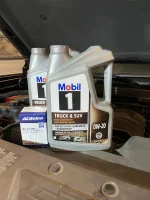As you and I have gone over previously, the catalyst part #'s are the exact same for the M1 0W-40 era cars and the Pennzoil cars. There is fundamentally no difference. Heck, if I remember correctly, the 5.7L cars from that era also had the same cats. This is a topic you and I are going to vehemently disagree on it appears, but this strikes me as a ridiculous boogeyman whose mythos has extended far beyond its reach.
I'm honestly not sure why you'd have concerns here. We are talking a few hundred PPM difference, if you are consuming enough oil for that to be a problem, it's not going to matter which oil you are using. Sure, it might get you out of the warranty period, but they are still going to fail regardless of which oil you are using.
And yes, newer Euro vehicles stopped using full-SAPS oils when GPF's were introduced, which we've also already been over. GPF's are more sensitive to poisoning than traditional catalysts, and this also coincided with many shifting to lighter oils, which will naturally have a higher tendency to consume. And then of course there's the issue with LSPI. None of this applies to the 5.7L, 6.4L and 6.2L HEMI engines however, which are port injected and backed by traditional catalysts.
What revisions? The Apache 6.4L SRT engine has remained almost entirely unchanged since it was introduced, save a few small tweaks that increased power output, and that was relatively early on and of course several lifter revisions, which we've also been over. There's nothing that would, or even could, be done to the engine to change the suitability of a full-SAPS lubricant besides slapping a GPF behind it and we know that isn't happening.
- The SRT 6.4L/392 was introduced in 2011
- The truck 6.4L (HD) version was introduced in 2014
- Hellcat 6.2L was introduced in 2014 (2015 MY)
The acquisition of Chrysler by FIAT didn't complete until January of 2014. However,
the SRT Pennzoil product was introduced mid-2012.
Hellcat engine development started in early 2011.
So no, I would assume the Hellcat engine was developed on, and validated with Mobil 1 0W-40, since it started before the Pennzoil product existed.
Of course it wasn't until after the acquisition that FIAT scrapped the factory and service fill contract with Mobil and tossed together the SRT oil and it took quite a while for dealers to get it. Mine was still using Mobil products for quite a while after, only getting in the Pennzoil products as the Mobil products were getting replaced.
The main difference here is that the SRT oil is a one-trick pony with 13% Noack and an API SN/GF-6 style additive package, with no other approvals, while the Euro lubes all have 229.5 (10% Noack limit) A3/B4, Porsche A40, VW 502...etc. Tons of OEM testing.
If the comparison is to be mid or low-SAPS, M1 ESP X3 0W-40 is Porsche C40, MB 229.31/229.51/229.52, VW 511 00 and dexos 2. BUT,
it has 900ppm of phosphorous. So, even for GPF protection, the phosphorous levels remain (significantly) higher than what we see in the SRT oil.
The SRT 0W-40 has ~700ppm of phosphorous
according to the Blackstone UOA so I don't even think it's fair to call it mid or low SAPS, as it has lower phosphorous than those. I will reiterate, it's very much just an API SN/SN Plus/SP GF-5/GF-6 additive package in a 0W-40. It could have been a 5W-30, and, if you look at that VOA and trust Blackstone, that sample I linked was one, lol.
This really shouldn't be surprising, the Corvette and LSx family recommended M1 5W-30 for aeons, recommending a heavier (and more heavily fortified) oil for track use (the Corvette Factory Race team used M1 0W-40, 'vette manual recommended M1 15W-50 IIRC). They've of course now shifted to the DexosR requirement, not sure if we have a VOA yet on that or not?



